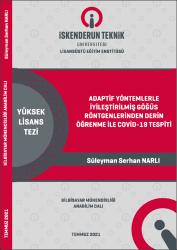| dc.contributor.advisor | Altan, Gökhan | |
| dc.contributor.author | Narlı, Süleyman Serhan | |
| dc.date.accessioned | 2021-12-27T20:34:54Z | |
| dc.date.available | 2021-12-27T20:34:54Z | |
| dc.date.issued | 2021 | en_US |
| dc.identifier.citation | Narlı, S. S. (2021). Adaptif yöntemlerle iyileştirilmiş göğüs röntgenlerinden derin öğrenme ile COVID-19 tespiti. (Yüksek Lisans Tezi). İskenderun Teknik Üniversitesi / Lisansüstü Eğitim Enstitüsü, Hatay. | en_US |
| dc.identifier.uri | https://hdl.handle.net/20.500.12508/1993 | |
| dc.description.abstract | Derin Öğrenme (DL), günümüzde en popüler Makine Öğrenme (ML) algoritmasıdır, Medikal Görüntü işleme alanında sınıflandırmadaki yüksek performansı sayesinde gün geçtikçe kullanımı yaygınlaşmaktadır. Derin Öğrenme bir sinir ağı yapısından esinlenerek oluşturulmuştur ve birçok parametre içermektedir, yüksek başarımından dolayı birçok hastalığın sınıflandırmasında kullanılmaktadır. Görüntü işleme alanında da oldukça sık kullanılan Derin Öğrenme algoritmaları, görüntü üzerindeki pikselleri farklı katmanlarda işleyerek sınıflandırma yapmaktadır. Görüntü DL ile sınıflandırmadan önce üzerinde farklı önişleme metotları ile sınıflandırmanın daha başarılı olmasını sağlanabilmektedir. Bu çalışmada Yerel Histogram Eşitleme (LHE) ve Uyarlanabilir Histogram Eşitleme (UHE) kullanılarak farklı Derin Öğrenme mimarilerinin COVID üzerindeki etkisi araştırılmıştır, görüntüler, Histogram Eşitleme kullanılarak ve Histogram Eşitleme kullanılmadan incelenerek bu filtrenin başarıma olan etkisi belirlenmiştir, Ayrıca her iki Histogram Eşitleme için farklı parametreler test edilerek en başarılı parametreler belirlenmiştir. Sınıflandırma için Chest X-Ray görüntüleri kullanılmıştır, veriseti COVID, Pneumonia ve Normal görüntülerden oluşmaktadır, Akciğer görüntüleri veriseti üzerinde iki ayrı düzenleme yapılarak birinci veriseti akciğer görüntüleri sağ ve sol lob olarak kırpılmıştır, ikinci veriseti üzerinde herhangi bir kırpma işlemi yapılmamıştır. Her bir Histogram Eşitleme farklı parametreler ile test edilerek her parametrenin başarıma olan etkisi gözlemlenmiştir. DarkNet19, VGG16, AlexNet, MobileNet ve Inception gibi farklı DL mimarileri kullanılarak sınıflandırma başarımı tespit edilmiştir. Bu modeller küçük veriseti ile eğitilerek öğrenim transferi ile daha büyük veriseti üzerinde test edilmiştir, böylece küçük veriseti ile öğrenilen ağırlıkların büyük veri setinde test edilmesi ile başarım sonuçları elde edilmiştir. | en_US |
| dc.description.abstract | Deep Learning (DL) is the most popular Machine Learning (ML) algorithm today. Its use is becoming widespread day by day thanks to its high performance in classification in the field of Medical Image processing. Deep Learning is inspired by a neural network structure and includes many parameters. Due to its high performance, it is used in the classification of many diseases. Deep Learning algorithms, which are frequently used in the field of image processing, classify the pixels on the image by processing them in different layers. Before classifying the image with DL, it can be ensured that the classification is more successful with different preprocessing methods. In this study, the effect of different Deep Learning architectures on COVID was investigated using Local Histogram Equalization (LHE) and Adaptive Histogram Equalization (UHE), images were examined using Histogram Equalization and without using Histogram Equalization, and the effect of this filter on achievement was determined. The most successful parameters were determined by testing. Chest X-Ray images were used for classification, the dataset consists of COVID, Pneumonia and Normal images, Lung images were made in two separate arrangements on the dataset, and the first dataset was cropped as right and left lobe lung images, no clipping was performed on the second dataset. Each Histogram Equalization was tested with different parameters and the effect of each parameter on achievement was observed. Classification performance has been determined using different DL architectures such as DarkNet19, VGG16, AlexNet, MobileNet and Inception. These models were trained with a small dataset and tested on a larger dataset with learning transfer, so performance results were obtained by testing the weights learned with a small dataset on a large dataset. | en_US |
| dc.language.iso | tur | en_US |
| dc.publisher | İskenderun Teknik Üniversitesi / Lisansüstü Eğitim Enstitüsü / Bilgisayar Mühendisliği Ana Bilim Dalı | en_US |
| dc.rights | info:eu-repo/semantics/openAccess | en_US |
| dc.subject | Medikal görüntü işleme | en_US |
| dc.subject | Covid-19 | en_US |
| dc.subject | Derin öğrenme | en_US |
| dc.subject | Yerel histogram eşitleme | en_US |
| dc.subject | Pnömoni | en_US |
| dc.subject | Uyarlanabilir histogram eşitleme | en_US |
| dc.subject | Deep learning | en_US |
| dc.subject | Convolutional neural networks | en_US |
| dc.subject | Chest X-ray | en_US |
| dc.subject | Local histogram equalization | en_US |
| dc.subject | Medical image analysis | en_US |
| dc.subject | Adaptive histogram equalization | en_US |
| dc.title | Adaptif yöntemlerle iyileştirilmiş göğüs röntgenlerinden derin öğrenme ile COVID-19 tespiti | en_US |
| dc.title.alternative | COVID-199 detection using deep learning on chest X-rays enhanced by adaptive methods | en_US |
| dc.type | masterThesis | en_US |
| dc.contributor.department | Mühendislik ve Doğa Bilimleri Fakültesi | en_US |
| dc.contributor.authorID | 0000-0001-7883-3131 | en_US |
| dc.relation.publicationcategory | Tez | en_US |
| dc.contributor.isteauthor | Altan, Gökhan | |
| dc.relation.index | İndeks Bilgisi Yok | en_US |
















